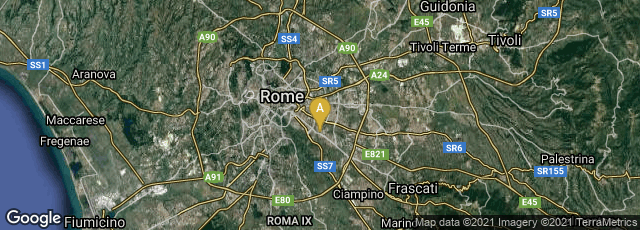The Portland Vase fragments after it was shattered in 1845. Watercolor by Thomas H. Shepherd (1845).


A Roman cameo glass vase, the Portland Vase, created between 30 BCE and 25 CE, and known since the Renaissance, served as an inspiration to many glass and porcelain makers from about the beginning of the 18th century onwards. It is about 25 centimeters high and 56 in circumference, made of violet-blue glass, and surrounded with a single continuous white glass cameo depicting seven figures of humans and gods. "On the bottom was a cameo glass disc, also in blue and white, showing a head, presumed to be of Paris or Priam on the basis of the Phrygian cap it wears. This roundel clearly does not belong to the vase, and has been displayed separately since 1845. It may have been added to mend a break in antiquity or after, or the result of a conversion from an original amphora form (paralleled by a similar blue-glass cameo vessel from Pompeii) - it was definitely attached to the bottom from at least 1826."
"The meaning of the images on the vase is unclear and controversial. Interpretations of the portrayals have included that of a marine setting (due to the presence of a ketos or sea-snake), and of a marriage theme/context (i.e. as a wedding gift). Many scholars (even Charles Towneley) have concluded that the figures do not fit into a single iconographic set."
"Cameo-glass vessels were probably all made within about two generations as experiments when the blowing technique (discovered in about 50 BC) was still in its infancy. Recent research has shown that the Portland vase, like the majority of cameo-glass vessels, was made by the dip-overlay method, whereby an elongated bubble of glass was partially dipped into a crucible (fire-resistant container) of white glass, before the two were blown together. After cooling the white layer was cut away to form the design."
"The work towards making a 19th century copy proved to be incredibly painstaking, and based on this it is believed that the Portland Vase must have taken its original artisan no less than two years to produce. The cutting was probably performed by a skilled gem-cutter. It is believed that the cutter may have been Dioskourides, as gems cut by him of a similar period and signed by him."
Traditionally the vase was believed to have been discovered by Fabrizio Lazzaro in the sepulchre of the Emperor Alexander Severus, at Monte del Grano near Rome, and excavated some time around 1582.
The first documented reference to the vase is a 1601 letter from the French scholar Nicolas Claude Fabri de Peiresc to the painter Peter Paul Rubens, where it is recorded as in the collection of Cardinal Francesco Maria Del Monte in Italy. It then passed to the Barberini family collection (which also included sculptures such as the Barberini Faun and Barberini Apollo) where it remained for some two hundred years, being one of the treasures of Maffeo Barberini, later Pope Urban VIII.
In 1778 Sir William Hamilton, British ambassador in Naples, purchased it from James Byres. "Byres, a Scottish art dealer, had acquired it after it was sold by Donna Cornelia Barberini-Colonna, Princess of Palestrina. She had inherited the vase from the Barberini family. Hamilton brought it to England on his next leave, after the death of his first wife, Catherine. In 1784, with the assistance of his niece, Mary, he arranged a private sale to Margaret Cavendish-Harley, widow of William Bentinck, 2nd Duke of Portland and so dowager Duchess of Portland. She passed it to her son William Cavendish-Bentinck, 3rd Duke of Portland in 1786.
"The 3rd Duke loaned the original vase to Josiah Wedgwood (see below) and then to the British Museum for safe-keeping, at which point it was dubbed the "Portland Vase". It was deposited there permanently by the fourth Duke in 1810, after a friend of his broke its base. The original Roman vase has remained in the British Museum ever since 1810, apart from three years (1929-32) when William Cavendish-Bentinck, 6th Duke of Portland put it up for sale at Christie's. It failed to reach its reserve. It was purchased by the Museum from William Cavendish-Bentinck, 7th Duke of Portland in 1945 with the aid of a bequest from James Rose Vallentin. . . .
"The 3rd Duke lent the vase to Josiah Wedgwood, who had already had it described to him as 'the finest production of Art that has been brought to England and seems to be the very apex of perfection to which you are endeavouring' by the sculptor John Flaxman. Wedgwood devoted four years of painstaking trials at duplicating the vase - not in glass but in jasperware. He had problems with his copies ranging from cracking and blistering (clearly visible on the example at the Victoria and Albert Museum) to the reliefs 'lifting' during the firing, and in 1786 he feared that he could never apply the Jasper relief thinly enough to match the glass original's subtlety and delicacy. He finally managed to perfect it in 1790, with the issue of the "first-edition" of copies (with some of this edition, including the V&A one, copying the cameo's delicacy by a combination of undercutting and shading the reliefs in grey), and it marks his last major achievement.
"Wedgwood put the first edition on private show between April and May 1790, with that exhibition proving so popular that visitor numbers had to be restricted by only printing 1900 tickets, before going on show in his public London showrooms. (One ticket to the private exhibition, illustrated by Samuel Alkin and printed with 'Admission to see Mr Wedgwood's copy of The Portland Vase, Greek Street, Soho, between 12 o'clock and 5', was bound into the Wedgwood catalogue on view in the Victoria and Albert Museum's British Galleries.) As well as the V&A copy (said to have come from the collection of Wedgwood's grandson, the naturalist Charles Darwin), others are held at the Fitzwilliam Museum (this is the copy sent by Wedgwood to Erasmus Darwin which his descendants loaned to the Museum in 1963 and later sold to them) and the Department of Prehistory and Europe at the British Museum.
"The Vase also inspired a 19th century competition to duplicate its cameo-work in glass, with Benjamin Richardson offering a £1000 prize to anyone who could achieve that feat. Taking three years, glass maker Philip Pargeter made a copy and John Northwood engraved it, to win the prize. This copy is in the Corning Museum of Glass in Corning, New York.
Vandalism and Reconstruction
"On February 7, 1845, the vase was shattered by William Lloyd, who drunkenly threw a nearby sculpture on top of the case smashing both it and the vase. The vase was pieced together with fair success, though the restorer was unable to replace all of the pieces and thirty-seven small fragments were lost. It appears they had been put into a box and forgotten. In 1948, the keeper Bernard Ashmole received thirty-seven fragments in a box from Mr. Croker of Putney, who did not know what they were. In 1845 Mr. Doubleday, the first restorer, did not know where these fragments went. A colleague had taken these to Mr. Gabb, a box maker, who was asked to make a box with thirty seven compartments, one for each fragment. The colleague died, the box was never collected, Gabb died and his executrix Miss Revees asked Croker to ask the museum if they could identify them. The Duke's descendants finally sold the vase to the museum in 1945.
"By 1948, the restoration appeared aged and it was decided to restore the vase again, but the restorer was only successful in replacing three fragments. The adhesive from this weakened, by 1986 the joints rattled when the vase was gently tapped. The third and current reconstruction took place in 1987, when a new generation of conservators assessed the vase's condition during its appearance as the focal piece of an international exhibition of Roman glass and, at the conclusion of the exhibition, it was decided to go ahead with reconstruction and stabilisation. The treatment had scholarly attention and press coverage. The vase was photographed and drawn to record the position of fragments before dismantling; the BBC filmed the conservation process. All previous adhesives had failed, so to find one that would last, conservation scientists at the museum tested many adhesives for long term stability. Finally, an epoxy resin with excellent ageing properties was chosen. Reassembly of the vase was made more difficult as the edges of some fragments were found to have been filed down during the restorations. Nevertheless, all of the fragments were replaced except for a few small splinters. Areas that were still missing were gap-filled with a blue or white resin.
"The newly conserved Portland Vase was returned to display. Little sign of the original damage is visible and except for light cleaning, the vase should not require major conservation work for many years." (Wikipedia article on Portland Vase, accessed 11-10-2009)